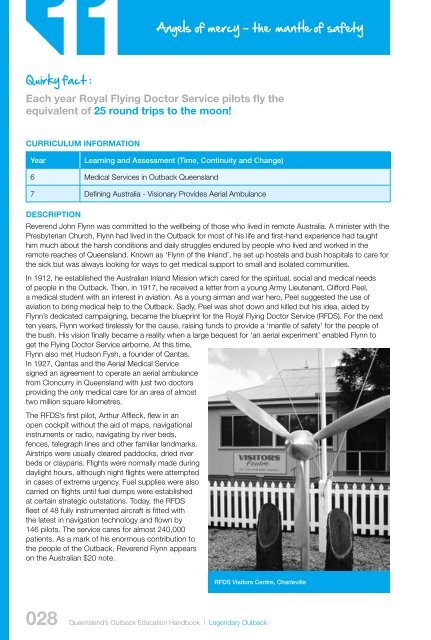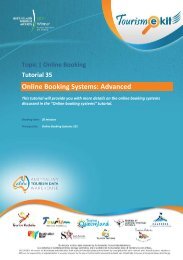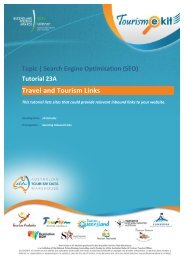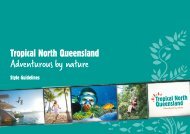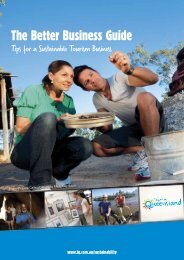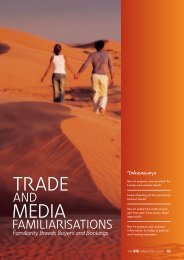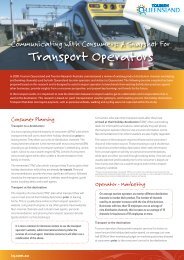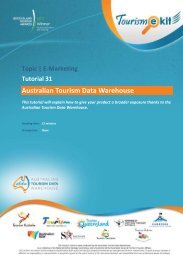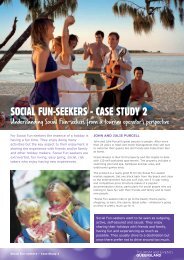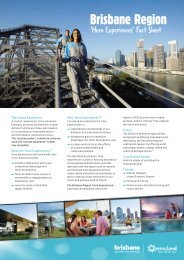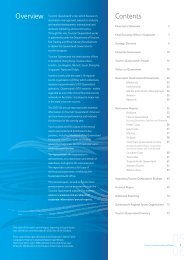Outback Education Handbook PDF - Tourism Queensland
Outback Education Handbook PDF - Tourism Queensland
Outback Education Handbook PDF - Tourism Queensland
Create successful ePaper yourself
Turn your PDF publications into a flip-book with our unique Google optimized e-Paper software.
11<br />
Angels<br />
Quirky fact :<br />
of mercy - the ‘mantle of safety’<br />
Each year Royal Flying Doctor Service pilots fly the<br />
equivalent of 25 round trips to the moon!<br />
Curriculum Information<br />
Year<br />
Learning and Assessment (Time, Continuity and Change)<br />
6 Medical Services in <strong>Outback</strong> <strong>Queensland</strong><br />
7 Defining Australia - Visionary Provides Aerial Ambulance<br />
Description<br />
Reverend John Flynn was committed to the wellbeing of those who lived in remote Australia. A minister with the<br />
Presbyterian Church, Flynn had lived in the <strong>Outback</strong> for most of his life and first-hand experience had taught<br />
him much about the harsh conditions and daily struggles endured by people who lived and worked in the<br />
remote reaches of <strong>Queensland</strong>. Known as ‘Flynn of the Inland’, he set up hostels and bush hospitals to care for<br />
the sick but was always looking for ways to get medical support to small and isolated communities.<br />
In 1912, he established the Australian Inland Mission which cared for the spiritual, social and medical needs<br />
of people in the <strong>Outback</strong>. Then, in 1917, he received a letter from a young Army Lieutenant, Clifford Peel,<br />
a medical student with an interest in aviation. As a young airman and war hero, Peel suggested the use of<br />
aviation to bring medical help to the <strong>Outback</strong>. Sadly, Peel was shot down and killed but his idea, aided by<br />
Flynn’s dedicated campaigning, became the blueprint for the Royal Flying Doctor Service (RFDS). For the next<br />
ten years, Flynn worked tirelessly for the cause, raising funds to provide a ‘mantle of safety’ for the people of<br />
the bush. His vision finally became a reality when a large bequest for ‘an aerial experiment’ enabled Flynn to<br />
get the Flying Doctor Service airborne. At this time,<br />
Flynn also met Hudson Fysh, a founder of Qantas.<br />
In 1927, Qantas and the Aerial Medical Service<br />
signed an agreement to operate an aerial ambulance<br />
from Cloncurry in <strong>Queensland</strong> with just two doctors<br />
providing the only medical care for an area of almost<br />
two million square kilometres.<br />
The RFDS’s first pilot, Arthur Affleck, flew in an<br />
open cockpit without the aid of maps, navigational<br />
instruments or radio, navigating by river beds,<br />
fences, telegraph lines and other familiar landmarks.<br />
Airstrips were usually cleared paddocks, dried river<br />
beds or claypans. Flights were normally made during<br />
daylight hours, although night flights were attempted<br />
in cases of extreme urgency. Fuel supplies were also<br />
carried on flights until fuel dumps were established<br />
at certain strategic outstations. Today, the RFDS<br />
fleet of 48 fully instrumented aircraft is fitted with<br />
the latest in navigation technology and flown by<br />
146 pilots. The service cares for almost 240,000<br />
patients. As a mark of his enormous contribution to<br />
the people of the <strong>Outback</strong>, Reverend Flynn appears<br />
on the Australian $20 note.<br />
RFDS Visitors Centre, Charleville<br />
028<br />
<strong>Queensland</strong>’s <strong>Outback</strong> <strong>Education</strong> <strong>Handbook</strong> | Legendary <strong>Outback</strong>


